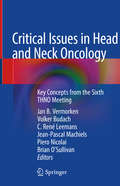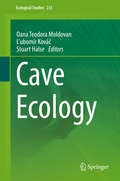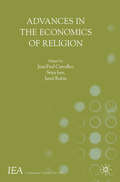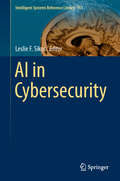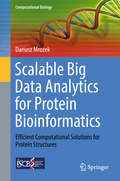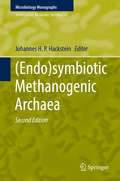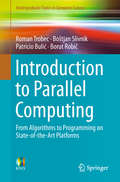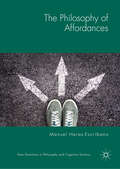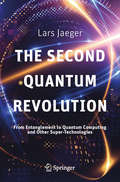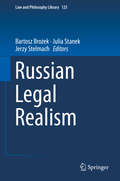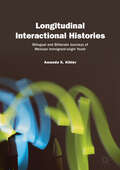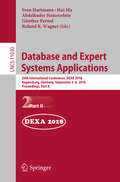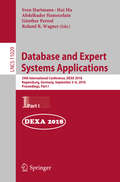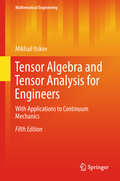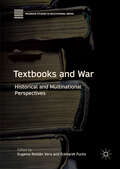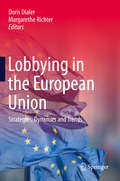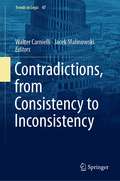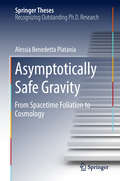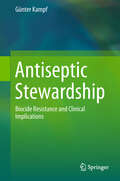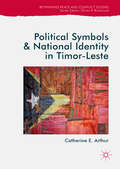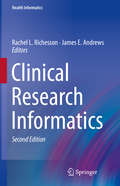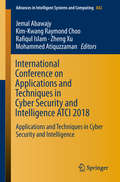- Table View
- List View
Critical Issues in Head and Neck Oncology: Key Concepts from the Sixth THNO Meeting
by Jan B. Vermorken Volker Budach C. René Leemans Jean-Pascal Machiels Piero Nicolai Brian O'SullivanThis book provides an overview of the latest advances in head and neck cancer using a multidisciplinary approach. Commencing with a discussion of epidemiological and diagnostic aspects, including the role of vaccination and key pathological features, the book then follows by examining the role of oncogenomics, proteomics, next generation sequencing and homologous recombination function in predicting outcomes. The topics are presented by epidemiologists, pathologists and basic scientists with further contributions from medical oncologists, head and neck cancer surgical specialists (ORL /HNS), and radiation oncologists in chapters that discuss therapeutic approaches for oral, oropharyngeal and thyroid cancer. Special topics such as the development of novel staging classifications, optimal larynx preservation approaches for laryngeal and hypopharyngeal cancer, surgical reconstruction, new surgical approaches in oropharynx cancer, potential for treatment de-escalation, systemic therapy in nasopharyngeal cancer and salivary gland tumors and treatment approaches for tumors of unknown primary site are discussed in detail. Finally, the role of immunotherapy in the field is highlighted. The chapters are based on the latest data presented at the 6th Trends in Head and Neck Oncology Conference and reflect the most up-to-date information in the field. They are written by many of the most internationally acclaimed authors in the field and are therefore an excellent source for all those interested or actively working in the field of head and neck cancer.
Cave Ecology (Ecological Studies #235)
by Oana Teodora Moldovan Ľubomír Kováč Stuart HalseCave organisms are the ‘monsters’ of the underground world and studying them invariably raises interesting questions about the ways evolution has equipped them to survive in permanent darkness and low-energy environments. Undertaking ecological studies in caves and other subterranean habitats is not only challenging because they are difficult to access, but also because the domain is so different from what we know from the surface, with no plants at the base of food chains and with a nearly constant microclimate year-round. The research presented here answers key questions such as how a constant environment can produce the enormous biodiversity seen below ground, what adaptations and peculiarities allow subterranean organisms to thrive, and how they are affected by the constraints of their environment. This book is divided into six main parts, which address: the habitats of cave animals; their complex diversity; the environmental factors that support that diversity; individual case studies of cave ecosystems; and of the conservation challenges they face; all of which culminate in proposals for future research directions. Given its breadth of coverage, it offers an essential reference guide for graduate students and established researchers alike.
Advances in the Economics of Religion (International Economic Association Series)
by Jean-Paul Carvalho Sriya Iyer Jared RubinThis edited collection brings together expertise from around the globe to overview and debate key concepts and concerns in the economics of religion. While the economics of religion is a relatively new field of research in economics, economists have made and continue to make important contributions to the understanding of religion. There is much scope for economists to continue to make a significant contribution to debates about religion, including its implications for conflict, political economy, public goods, demography, education, finance, trade and economic growth.
AI in Cybersecurity (Intelligent Systems Reference Library #151)
by Leslie F. SikosThis book presents a collection of state-of-the-art AI approaches to cybersecurity and cyberthreat intelligence, offering strategic defense mechanisms for malware, addressing cybercrime, and assessing vulnerabilities to yield proactive rather than reactive countermeasures. The current variety and scope of cybersecurity threats far exceed the capabilities of even the most skilled security professionals. In addition, analyzing yesterday’s security incidents no longer enables experts to predict and prevent tomorrow’s attacks, which necessitates approaches that go far beyond identifying known threats. Nevertheless, there are promising avenues: complex behavior matching can isolate threats based on the actions taken, while machine learning can help detect anomalies, prevent malware infections, discover signs of illicit activities, and protect assets from hackers. In turn, knowledge representation enables automated reasoning over network data, helping achieve cybersituational awareness. Bringing together contributions by high-caliber experts, this book suggests new research directions in this critical and rapidly growing field.
Scalable Big Data Analytics for Protein Bioinformatics: Efficient Computational Solutions For Protein Structures (Computational Biology #28)
by Dariusz MrozekThis book presents a focus on proteins and their structures. The text describes various scalable solutions for protein structure similarity searching, carried out at main representation levels and for prediction of 3D structures of proteins. Emphasis is placed on techniques that can be used to accelerate similarity searches and protein structure modeling processes.The content of the book is divided into four parts. The first part provides background information on proteins and their representation levels, including a formal model of a 3D protein structure used in computational processes, and a brief overview of the technologies used in the solutions presented in the book. The second part of the book discusses Cloud services that are utilized in the development of scalable and reliable cloud applications for 3D protein structure similarity searching and protein structure prediction. The third part of the book shows the utilization of scalable Big Data computational frameworks, like Hadoop and Spark, in massive 3D protein structure alignments and identification of intrinsically disordered regions in protein structures. The fourth part of the book focuses on finding 3D protein structure similarities, accelerated with the use of GPUs and the use of multithreading and relational databases for efficient approximate searching on protein secondary structures.The book introduces advanced techniques and computational architectures that benefit from recent achievements in the field of computing and parallelism. Recent developments in computer science have allowed algorithms previously considered too time-consuming to now be efficiently used for applications in bioinformatics and the life sciences. Given its depth of coverage, the book will be of interest to researchers and software developers working in the fields of structural bioinformatics and biomedical databases.
(Endo)symbiotic Methanogenic Archaea
by Johannes H. HacksteinThis updated monograph deals with methanogenic endosymbionts of anaerobic protists, in particular ciliates and termite flagellates, and with methanogens in the gastrointestinal tracts of vertebrates and arthropods. Further chapters discuss the genomic consequences of living together in symbiotic associations, the role of methanogens in syntrophic degradation, and the function and evolution of hydrogenosomes, hydrogen-producing organelles of certain anaerobic protists. Methanogens are prokaryotic microorganisms that produce methane as an end-product of a complex biochemical pathway. They are strictly anaerobic archaea and occupy a wide variety of anoxic environments. Methanogens also thrive in the cytoplasm of anaerobic unicellular eukaryotes and in the gastrointestinal tracts of animals and humans. The symbiotic methanogens in the gastrointestinal tracts of ruminants and other “methanogenic” mammals contribute significantly to the global methane budget; especially the rumen hosts an impressive diversity of methanogens. This makes this updated volume an interesting read for scientists and students in Microbiology and Physiology.
Introduction to Parallel Computing: From Algorithms To Programming On State-of-the-art Platforms (Undergraduate Topics in Computer Science)
by Borut Robič Patricio Bulić Boštjan Slivnik Roman TrobecAdvancements in microprocessor architecture, interconnection technology, and software development have fueled rapid growth in parallel and distributed computing. However, this development is only of practical benefit if it is accompanied by progress in the design, analysis and programming of parallel algorithms. This concise textbook provides, in one place, three mainstream parallelization approaches, Open MPP, MPI and OpenCL, for multicore computers, interconnected computers and graphical processing units. An overview of practical parallel computing and principles will enable the reader to design efficient parallel programs for solving various computational problems on state-of-the-art personal computers and computing clusters. Topics covered range from parallel algorithms, programming tools, OpenMP, MPI and OpenCL, followed by experimental measurements of parallel programs’ run-times, and by engineering analysis of obtained results for improved parallel execution performances. Many examples and exercises support the exposition.
The Philosophy of Affordances (New Directions In Philosophy And Cognitive Science Ser.)
by Manuel Heras-EscribanoThis book is the first monograph fully devoted to analyzing the philosophical aspects of affordances. The concept of affordance, coined and developed in the field of ecological psychology, describes the possibilities for action available in the environment. This work offers a systematic approach to the key philosophical features of affordances, such as their ontological characterization, their relation to normative practices, and the idea of agency that follows from viewing affordances as key objects of perception, while also proposing an innovative philosophical characterization of affordances as dispositional properties. The Philosophy of Affordances analyzes the implications that a proper understanding of affordances has for the philosophy of mind and the cognitive sciences, and aims to intensify the dialogue between philosophy and ecological psychology in which each discipline benefits from the tools and insights of the other.
e-Infrastructure and e-Services for Developing Countries: 9th International Conference, Africomm 2017, Lagos, Nigeria, December 11-12, 2017, Proceedings (Lecture Notes of the Institute for Computer Sciences, Social Informatics and Telecommunications Engineering #250)
by Victor Odumuyiwa Ojo Adegboyega Charles UwadiaThis book constitutes the thoroughly refereed proceedings of the 9th International Conference on e-Infrastructure and e-Services for Developing Countries, AFRICOMM 2017, held in Lagos, Nigeria, in December 2017. The 19 full papers, 12 short papers and 5 workshop papers were carefully selected from 81 submissions. The papers were presented in eight sessions: e-government, network and load management, digital inclusion, knowledge extraction, representation and sharing, networks and communications, ICT applications for development, decision support, e-business and e-services, internet measurement.
The Second Quantum Revolution: From Entanglement to Quantum Computing and Other Super-Technologies
by Lars JaegerThis book tells the story of the second quantum revolution which will shape the 21st century as much as the first quantum revolution shaped the 20th century. It provides unique orientation in today's discussion and the latest progress on the interpretation of quantum physics and its further technological potential. As you read this book the first prototypes of this revolution are being built in laboratories worldwide. Super-technologies such as nanotechnology, quantum computers, quantum information processing, and others will soon shape our daily lives, even if physicists themselves continue to disagree on how to interpret the central theory of modern physics. The book will thus also touch on the profound philosophical questions at the heart of quantum mechanics.
Russian Legal Realism (Law and Philosophy Library #125)
by Bartosz Brożek Julia Stanek Jerzy StelmachThis edited volume explores ideas of legal realism which emerge through the works of Russian legal philosophers. Apart from the well-known American and Scandinavian versions of legal realism, there also exists a Russian one: readers will discover fresh perspectives and that the collection of early twentieth century ideas on law discussed in Russia can be understood as a unified school of legal thought – as Russian legal realism. <p><p> These chapters by renowned European and Eastern European legal philosophers add to ongoing discussions about the nature of law, especially in the context of developments around our scientific knowledge about the mind and behaviour. Analyses of legal phenomena carried out by legal realists in Russia offer novel arguments in favour of embracing psychological and sociological perspectives on the law. The book includes analysis of the St. Petersburg school of legal philosophy and Leon Petrażycki’s psychological theory of law. <p> This original and multifaceted research on Russian realists is of considerable value to an international audience. Researchers and postgraduate students of law, legal theory and legal ethics will find the book particularly appealing, but it will also interest those investigating the philosophy or sociology of law, or legal history.
Longitudinal Interactional Histories: Bilingual and Biliterate Journeys of Mexican Immigrant-origin Youth
by Amanda K. KiblerThis book explores the lives of five Mexican immigrant-origin youths in the United States, documenting their language and literacy journeys over an eight-year period from adolescence to young adulthood. In these qualitative case studies, the author uses a “longitudinal interactional histories approach” (LIHA) to explore literacy events in which the young people participated over time, telling the stories behind texts they created in order to better understand opportunities for bilingual and biliterate development available inside and outside of formal schooling. The book begins with an overview and exploration of theories and research underpinning the project, with a focus on countering minoritizing discourses faced by many multilingual immigrant youth and prioritizing the “goodness” of their experiences. The study’s methodology, including LIHA, is presented, before individual case studies of all five youth are explored. The book closes with a synthesis of these cases and exploration of pedagogical, policy, and research implications. It will be of particular interest to students and scholars of education, applied linguistics and sociolinguistics, as well as teachers and policy-makers working with bilingual and biliterate immigrant youth.
Database and Expert Systems Applications: 29th International Conference, DEXA 2018, Regensburg, Germany, September 3–6, 2018, Proceedings, Part II (Lecture Notes in Computer Science #11030)
by Sven Hartmann Hui Ma Abdelkader Hameurlain Günther Pernul Roland R. WagnerThis two volume set of LNCS 11029 and LNCS 11030 constitutes the refereed proceedings of the 29th International Conference on Database and Expert Systems Applications, DEXA 2018, held in Regensburg, Germany, in September 2018.The 35 revised full papers presented together with 40 short papers were carefully reviewed and selected from 160 submissions. The papers of the first volume discuss a range of topics including: Big data analytics; data integrity and privacy; decision support systems; data semantics; cloud data processing; time series data; social networks; temporal and spatial databases; and graph data and road networks. The papers of the second volume discuss a range of the following topics: Information retrieval; uncertain information; data warehouses and recommender systems; data streams; information networks and algorithms; database system architecture and performance; novel database solutions; graph querying and databases; learning; emerging applications; data mining; privacy; and text processing.
Database and Expert Systems Applications: 29th International Conference, DEXA 2018, Regensburg, Germany, September 3–6, 2018, Proceedings, Part I (Lecture Notes in Computer Science #11029)
by Sven Hartmann Hui Ma Abdelkader Hameurlain Günther Pernul Roland R. WagnerThis two volume set of LNCS 11029 and LNCS 11030 constitutes the refereed proceedings of the 29th International Conference on Database and Expert Systems Applications, DEXA 2018, held in Regensburg, Germany, in September 2018. The 35 revised full papers presented together with 40 short papers were carefully reviewed and selected from 160 submissions. The papers of the first volume discuss a range of topics including: Big data analytics; data integrity and privacy; decision support systems; data semantics; cloud data processing; time series data; social networks; temporal and spatial databases; and graph data and road networks. The papers of the second volume discuss a range of the following topics: Information retrieval; uncertain information; data warehouses and recommender systems; data streams; information networks and algorithms; database system architecture and performance; novel database solutions; graph querying and databases; learning; emerging applications; data mining; privacy; and text processing.
Tensor Algebra and Tensor Analysis for Engineers: With Applications To Continuum Mechanics (Mathematical Engineering Ser.)
by Mikhail ItskovThis is the fifth and revised edition of a well-received textbook that aims at bridging the gap between the engineering course of tensor algebra on the one hand and the mathematical course of classical linear algebra on the other hand. In accordance with the contemporary way of scientific publication, a modern absolute tensor notation is preferred throughout. The book provides a comprehensible exposition of the fundamental mathematical concepts of tensor calculus and enriches the presented material with many illustrative examples. As such, this new edition also discusses such modern topics of solid mechanics as electro- and magnetoelasticity. In addition, the book also includes advanced chapters dealing with recent developments in the theory of isotropic and anisotropic tensor functions and their applications to continuum mechanics. Hence, this textbook addresses graduate students as well as scientists working in this field and in particular dealing with multi-physical problems. In each chapter numerous exercises are included, allowing for self-study and intense practice. Solutions to the exercises are also provided.
Textbooks and War: Historical and Multinational Perspectives (Palgrave Studies in Educational Media)
by Eugenia Roldán Vera Eckhardt FuchsThis volume reflects on the role played by textbooks in the complex relationship between war and education from a historical and multinational perspective, asking how textbook content and production can play a part in these processes. It has long been established that history textbooks play a key role in shaping the next generation’s understanding of both past events and the concept of ‘friend’ and ‘foe’. Considering both current and historical textbooks, often through a bi-national comparative approach, the editors and contributors investigate various important aspects of the relationships between textbooks and war, including the role wars play in the creation of national identities (whether the country is on the winning or losing side), the effacement of international wars to highlight a country’s exceptionalism, or the obscuring of intra-national conflict through the ways in which a civil war is portrayed. This pioneering book will be of interest and value to students and scholars of textbooks, educational media and the relationships between curricula and war.
Lobbying in the European Union: Strategies, Dynamics And Trends
by Doris Dialer Margarethe RichterThis book sheds new light on how lobbying works in the European Union. Drawing on the first-hand professional experience of lobbyists, policymakers, and corporate and institutional stakeholders, combined with a sound academic foundation, it offers insights into successful lobbying strategies, such as how alliances are formed by interest groups in Brussels. The authors present key case studies, e.g. on the shelved EU-US trade deal Transatlantic Trade and Investment Partnership (TTIP), lobbying scandals, and the role of specific interest groups and EU Think-Tanks. Furthermore, they highlight efforts to improve transparency and ethical standards in EU decision-making, while also underscoring the benefits of lobbying in the context of decision-making. Understanding the tools and techniques of effective lobbying, as well as the dynamics and trends in EU lobbying, will allow professionals involved in the lobbying process, such as policymakers and corporate and institutional stakeholders, to improve their performance and achieve better results when pursuing their respective interests.
Contradictions, from Consistency to Inconsistency (Trends in Logic #47)
by Walter Carnielli Jacek MalinowskiThis volume investigates what is beyond the Principle of Non-Contradiction. It features 14 papers on the foundations of reasoning, including logical systems and philosophical considerations. Coverage brings together a cluster of issues centered upon the variety of meanings of consistency, contradiction, and related notions. Most of the papers, but not all, are developed around the subtle distinctions between consistency and non-contradiction, as well as among contradiction, inconsistency, and triviality, and concern one of the above mentioned threads of the broadly understood non-contradiction principle and the related principle of explosion. Some others take a perspective that is not too far away from such themes, but with the freedom to tread new paths. Readers should understand the title of this book in a broad way,because it is not so obvious to deal with notions like contradictions, consistency, inconsistency, and triviality. The papers collected here present groundbreaking ideas related to consistency and inconsistency.
Asymptotically Safe Gravity: From Spacetime Foliation To Cosmology (Springer Theses)
by Alessia Benedetta PlataniaThis book seeks to construct a consistent fundamental quantum theory of gravity, which is often considered one of the most challenging open problems in present-day physics. It approaches this challenge using modern functional renormalization group techniques, and attempts to realize the idea of “Asymptotic Safety” originally proposed by S. Weinberg. Quite remarkably, the book makes significant progress regarding both the fundamental aspects of the program and its phenomenological consequences. The conceptual developments pioneer the construction of a well-behaved functional renormalization group equation adapted to spacetimes with a preferred time-direction. It is demonstrated that the Asymptotic Safety mechanism persists in this setting and extends to many phenomenologically interesting gravity-matter systems. These achievements constitute groundbreaking steps towards bridging the gap between quantum gravity in Euclidean and Lorentzian spacetimes.The phenomenological applications cover core topics in quantum gravity, e.g. constructing a phenomenologically viable cosmological evolution based on quantum gravity effects in the very early universe, and analyzing quantum corrections to black holes forming from a spherical collapse.As a key feature, all developments are presented in a comprehensive and accessible way. This makes the work a timely and valuable guide into the rapidly evolving field of Asymptotic Safety.
Russian Contributions to Analytical Chemistry
by Yury A. ZolotovThis book offers a unique perspective and novel information on the significant contributions of Russian scientists to analytical chemistry and chemical analysis. Written by the Editor-in-Chief of the Journal of Analytical Chemistry, it discusses various examples of new methods and approaches originating in Russia, such as chromatography, electrothermal atomic absorption spectrometry, Kumakhov X-ray optics, the Spolský effect in fluorescent analysis and important innovations in mass spectrometry, which are already widely used. Other original developments, such as the chromatomembrane and stoichiographic methods, are on their way to international recognition. Tremendous expertise in the analysis of minerals and high-purity and special-purpose substances has accumulated in Russian laboratories, and as such this book appeals to anyone interested in the development of science in Russia; to physicists, chemists, and other specialists dealing with chemical analysis; and to postgraduates and students of chemistry-related disciplines.
Alcohol and Cancer: Proceedings of the Third International Conference (Advances in Experimental Medicine and Biology #1032)
by Vasilis Vasiliou Samir Zakhari Lopa Mishra Helmut K. SeitzFollowing the Third Alcohol and Cancer Conference, this volume compiles the most up-to-date research on the role of alcohol consumption in carcinogenesis, from epidemiology to pathology metabolism and stem cells. More specifically, it delves into the effects of alcohol consumption and thyroid cancer, CD133+ progenitor cells, carcinogenic iron accumulation, developmental morphogens, and cancer-inducing epigenetic changes. Alcohol and Cancer: Proceedings of the Third International Conference is a timely update to Biological Basis of Alcohol-Induced Cancer, which followed the Second Alcohol and Cancer Conference, compiling cutting-edge research from graduate students, young scientists, and researchers. It is ideal for graduate students and researchers in oncology, hepatology, epigenetics, and alcohol consumption.
Antiseptic Stewardship: Biocide Resistance and Clinical Implications
by Günter KampfVarious antiseptic agents, such as chlorhexidine, are used for different applications, e.g. in healthcare, veterinary medicine, animal production and household products, including cosmetics. However, not all antiseptic agents provide significant health benefits, especially in some products used in human medicine (alcohol-based hand rubs, antimicrobial soaps). While some products (antimicrobial soaps, surface disinfectants, instrument disinfectants, wound antiseptics) may contain one or more biocidal agents with a comparable antimicrobial efficacy but large differences in their potential for microbial adaptation and tolerance. An increased bacterial resistance has been described for various antimicrobial agents, sometimes including a cross-resistance to antibiotics. The book is the first comprehensive reference resource on antiseptic agents, including their efficacy, natural and acquired resistance, adaptation, and cross-resistance. It also discusses their and appropriate use in terms of a balance between their efficacy and the risk of acquired bacterial resistance / tolerance. Focusing on human and veterinary medicine and household products, it helps readers make informed decisions concerning against antiseptic products based on their composition. The book contributes to reduce any unnecessary selection pressure towards emerging pathogens and to keep the powerful antiseptic agents for all those applications that have a clear benefit (e.g. reduction of healthcare-associated infection).
Political Symbols and National Identity in Timor-Leste (Rethinking Peace and Conflict Studies)
by Catherine E. ArthurThis book explores how national identity has been negotiated and (re)imagined through the political symbols that embody it in post-conflict Timor-Leste. It develops a Modernist approach to nations and nationalism by incorporating Bourdieusian theories of symbolic capital and conflict, to examine how national identity has been constructed and represented in political symbols. Taking case studies of flags, monuments, national heroes, and street art, it critically analyses how a diverse population has interpreted and (re)constructed its national identity throughout the first decade of independence, and how the transition from a context of conflict to peace has influenced such popular imaginings. By examining these processes of identification with a wide range of symbols, the book discusses the numerous challenges that this young nation-state still faces, including victimhood and recognition, democratization and electoral politics, the political role of cosmology and spirituality, and post-colonial generational differences and divisions.
Clinical Research Informatics (Health Informatics)
by Rachel L. Richesson James E. AndrewsClinical research informatics (CRI) is the application of informatics principles and techniques to support the spectrum of activities and business processes that instantiate clinical research. Informatics, defined generally as the intersection of information and computer science with a health-related discipline, has a foundation drawn from many well-established, theory-based disciplines, including computer science, library and information science, cognitive science, psychology, and sociology. The newly articulated yet fundamental theorem of informatics states that information technology should be used to enable humans to function and perform better together than humans alone, and so informatics is a source for supportive technologies and tools that enhance – but not replace – unreservedly human processes. Clinical Research Informatics contributes to the ongoing dialogues among researchers and practitioners in CRI as they continue to rise to the challenges of a dynamic and evolving clinical research environment. The development of CRI as a sub-discipline of informatics, and as an independent/maturing professional practice area in its own right, drives a growing pool of scientific literature based on original CRI research, and high-impact tools and systems will be developed. CRI leaders and stakeholder groups will continue to support and create communities of discourse that will address much needed practice standards in CRI, improved safety and efficiencies in clinical research, data standards in clinical research, policy issues, educational standards and instructional resources. The Editors and contributors to this book are among the most active and engaged in the CRI domain and provide an excellent primer for deeper explorations into this emerging discipline. Certain themes are highlighted, including the changing role of the consumer, movement toward transparency, growing needs for global coordination and cooperation on many levels, and the merging together of clinical care delivery and research as part of a changing paradigm in global healthcare delivery – all in the context of rapid innovations in technology and explosions of data sources, types, and volume. This book is therefore of considerable interest to all students of biomedical informatics, from the newcomer to the professional informatician.
International Conference on Applications and Techniques in Cyber Security and Intelligence ATCI 2018: Applications And Techniques In Cyber Security And Intelligence (Advances In Intelligent Systems and Computing #842)
by Jemal Abawajy Kim-Kwang Raymond Choo Rafiqul Islam Zheng Xu Mohammed AtiquzzamanThe book highlights innovative ideas, cutting-edge findings, and novel techniques, methods and applications touching on all aspects of technology and intelligence in smart city management and services. Above all, it explores developments and applications that are of practical use and value for Cyber Intelligence-related methods, which are frequently used in the context of city management and services.
